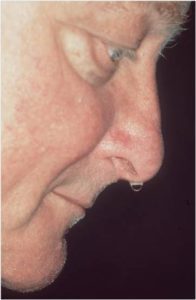
What is Cerebrospinal Fluid Rhinorrhoea/ CSF Rhinorrhoea?
Cerebrospinal fluid rhinorrhea is a sign of basal skull fracture.
If there is an immediate leak, it means there occur dural tear, bone defect or fracture. If there is a delayed traumatic leak then the major cause is the previously intact dural layer that has slowly become herniated through a bony defect finally tearing the dura and causing the leak.
Spontaneous CSF rhinorrhea is manifested in adulthood, and coinciding with a developmental rise in CSF pressure with increasing age.
What is the age /sex prevalence of CSF Rhinorrhoea?
CSF rhinorrhoea can occur at any age.
There is no evidence of any particular. Individuals of any race can be affected by CSF rhinorrhoea.
How do you get affected with CSF Rhinorrhoea?
Injury to skull due to an accident is the major cause.
Traumatic causes are as follows:-
• Non surgical causes
Blunt trauma such as non surgical fracture.
Projectile trauma.
• Surgical causes
Paranasal sinus surgery.
Skull base tumor ablation.
Tran sphenoidal surgery.
Craniotomy.
Spontaneous or non-traumatic causes:-
• High blood pressure flow-
Intracranial tumors.
Hydrocephalus.
• Low blood pressure flow-
Sellar atrophy.
Bony erosion, Osteomyelitis, Osteonecrosis.
Olfactory atrophy/ focal cerebral atrophy.
Congenital defects of the skull base.
Pneumatized bone.
Idiopathic.
What are the signs and symptoms of CSF Rhinorrhoea?
The most common symptom of CSF rhinorrhoea is unilateral clear watery nasal discharge with a salty taste.
• Dripping of watery fluid in the back of the throat.
• Lead occurs due to the following conditions
High pressure- builds up over time and relieved by the sudden discharge of fluid. Low pressure- a postural headache relieved by reclining.
• A large amount of fluid flowing out of the nose during a change in a head position indicates that a sinus filled with CSF is drained at once.
• There are recurrent attacks of a headache, fever, and meningitis in a patient who have a history of head trauma.
• Imbalance, dizziness, hearing loss.
What investigations are required in case of CSF Rhinorrhoea?
The investigation starts with physical examination and physical examination include the following steps:-
– Complete rhinology, otologic, head, and neck, and neurological evaluations.
– Endoscopy is helpful to detect encephalocele or meningocele.
– Target sign/ halo sign: pseudo chromatographic pattern produced by a differential diagnosis of CSF admixed with blood or serosanguinous fluid on filter paper- CSF produces a bull’s eye pattern with blood in the center.
– Glucose levels
CSF->=50-60% serum concentration.
Nasal secretion- <=10mg%. Chloride concentration >110m/Eq/L- most likely CSF.
Qualitative spot test- Dextrostix.
-not definitive
-negative test excludes the presence of CSF.
Imaging techniques helpful are as follows:-
• Plain X-ray skull
Basilar skull fracture.
An air-fluid level in the PNS
• CT scan skull with bone windows.
• CT cisternography.
• MRI skull.
What are the complications of CSF Rhinorrhoea?
• Meningitis.
• Pneumocephalus.
• Cerebral abscess.
• Encephalitis.
• A headache.
• Intracranial hemorrhages.
• Dural cutaneous fistula
Is CSF Rhinorrhoea Life-threatening condition?
If detected at the early stage can be treated with medications.
Complications can lead to death if infection occurs can cause coma also.
Explain the Management of CSF Rhinorrhoea patients?
-Conservative treatment
-Following points to be taken care of by the patient
• The position of the head elevated 30-40° to prevent a cranial leak.
• Avoid sneezing, coughing, straining.
• Careful monitoring is necessary to prevent the happening of meningitis or pneumocephalus.
• Antibiotics.
• Lastly, can be treated with surgery to stop the drainage.
